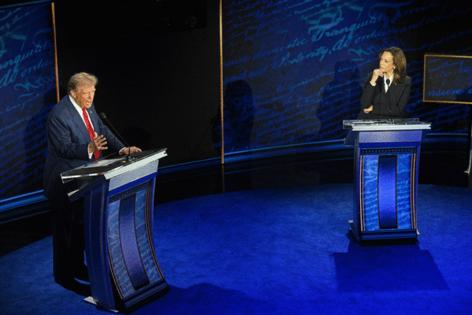Six trends that could decide Pennsylvania for Kamala Harris or Donald Trump
Published in Political News
Pennsylvania has emerged as the most crucial battleground state in one of the wildest presidential races in memory — with both campaigns battling for every last vote in the state that former President Donald Trump won eight years ago by just 44,000 votes.
Trump, who lost Pennsylvania in 2020, and Vice President Kamala Harris, the Democratic nominee, are both crisscrossing the commonwealth in hopes of eking out a win in the potentially decisive state.
Pennsylvania is unique in many ways — it's closely divided, and it's geographically diverse. It is also changing, according to an Inquirer analysis of election data and interviews with dozens of Pennsylvanians that informed a series of stories about voting trends this year.
Here are six major lessons about which Pennsylvania voters could sway the race — and the future of the country.
1. Suburbs and prosperous urban areas have moved more to Democrats, while rural areas and deep inner cities are trending toward Republicans.
In recent years, there's been a shift in the political allegiances of places once considered solidly blue or red. The suburbs have gotten more Democratic, while rural areas and some pockets of deep inner cities have moved toward Republicans. At the same time, some post-industrial pockets are a wild card — they backed Trump in 2016, but picked President Joe Biden in 2020.
Taken together, The Inquirer's analysis showed the middle has moved left since 2016, while Trump's vote count increased at the extremes.
The story may come down to education. Groups with higher percentages of college degree attainment shifted further toward Democrats, while those with lower post-secondary education shifted right.
What it means: The presidential candidate who wins Pennsylvania may not do so in a way we've seen before. Trump won the state in 2016 by carrying nearly every region except Philadelphia and its suburbs. Biden won Pennsylvania four years later by cutting into Trump's gains in coal and steel country, as well as driving up his margin in the suburbs.
Whomever prevails in Pennsylvania this year may do so by putting together a patchwork of support we haven't seen before.
That means both candidates are trying to compete everywhere. Trump is looking to grow among Latino voters in big and small cities. Harris will look to carry big margins in the suburbs and turn out Philly voters. And in the end, winning some of the most divided areas could prove to be most consequential.
2. The suburbs are growing and becoming more important for Democrats.
The suburbs have been trending blue for decades, especially in the voter-rich collar counties outside Philadelphia, but the once predominantly rural outer suburbs are also more recently trending Democratic. It's where the most dramatic Democratic vote growth has happened since 2016.
Take East Brandywine Township in Chester County. New housing has popped up on former farmland in the area, and the population has swelled, precipitating a political shift. Republican nominee Mitt Romney won the township in 2012, but President Joe Biden carried it comfortably in 2020. Interestingly, the number of Republican votes remained relatively unchanged — the difference came down to more Democrats living in the area.
Suburbs outside smaller cities are shifting blue, as well. For example, in the Harrisburg metro area, Democratic vote totals grew faster than Republican votes between 2016 and 2020.
What it means: Harris and her allies may zero in on the state's most voter-rich suburbs outside of Philly and Pittsburgh in the campaign's final stretch. But Republicans still have an edge in majority-white suburbs statewide, and a strong performance by Trump could blunt Harris' growth.
3. Democrats have lost some ground in Philly, especially with the working class.
Biden won Pennsylvania in 2020, but Democrats still bled more votes in Philly than in any other county, worrying some in the party this year. The biggest losses were in working-class communities, and the trend was most stark in majority Latino neighborhoods.
Democrats lost the most ground in neighborhoods where education levels were lowest and poverty rates were highest. At the same time, precincts in the city with the lowest poverty rates shifted furthest left.
In some working-class areas of the city, voters increasingly cast ballots for Trump. In others, Democratic vote totals declined largely because turnout did — fewer people showing up in blue strongholds is effectively a gain for Republicans.
What it means: Harris will undoubtedly carry Philadelphia, but the question is now: by how much? Trump and his allies are making a push in the city to lose by fewer votes than he did four years ago, and some polls suggest he could be successful.
Still, plenty of Philly voters haven't exactly flocked to Trump — they've just expressed ambivalence toward the Democratic party. That means Harris has an opening to reenergize the Democratic base and try to drive up turnout in the final days of the campaign.
4. The core of Republican support remains in rural areas.
Rural voters are the second largest voting group in the state following suburban voters, and they make up the core of Trump's support. That reflects a longtime marriage between the conservative ideology present there and the GOP, as well as a political realignment that has shifted some former Democrats rightward.
Geographically speaking, this means the widest swaths of Pennsylvania are still Trump country. Rural areas are losing population faster than other places in the state like the suburbs, but Trump still managed to increase his net vote share in rural regions in 2020 compared to 2016.
What it means: Harris may see an opportunity to cut into Trump's support in rural areas such as Lancaster County, which has trended to the left overall thanks to gains in some of its largest towns. But its large swaths of rural areas have become even more red since 2016, and Trump may look to grow there more this year.
5. Republicans have made inroads in Pennsylvania's small cities with growing Latino populations.
Democrats in 2020 carried Pennsylvania's three majority-Latino cities — Reading, Allentown, and Hazleton — but Republicans gained more votes than Democrats did compared to 2016.
Reading had particularly large Democratic losses and Republican gains, and Republican votes grew by the greatest numbers in the most deeply Latino parts of the city. Between 2016 and 2020, Trump's vote total in Reading grew by 37%. Biden logged 12% fewer votes in 2020 than 2016 Democratic nominee Hillary Clinton.
Trump's campaign clearly sees the area as ripe for growth. He held a rally in Reading last week, and his running mate, Sen. JD Vance, appeared at a town hall event there over the weekend.
What it means: Winning over Pennsylvania's Latino population could prove pivotal. If Trump can harness his growth with the bloc in 2020 and build on it, he could improve his vote totals in these traditionally Democratic strongholds.
6. Former manufacturing towns are unpredictable and could be the most determinative places in the state.
Many of Pennsylvania's once prosperous coal and steel towns have flip-flopped over the last three election cycles. Once Democratic strongholds, former President Barack Obama performed well in the areas, but Trump flipped many of them red in 2016. In 2020 though, Biden made gains, winning some of the ex-manufacturing towns back or at least blunting Trump's growth there.
These Rust Belt small towns and cities, such as Johnstown and Bristol, started on a rightward shift about a decade ago that was supercharged by Trump's populism. Though he lost the state in 2020, Trump pulled more votes out of many historically blue towns along the Susquehanna River in the Northeast and in Southwestern Pennsylvania than when he won it in 2016.
What it means: These towns could decide the election as Trump looks to shore up support with white, working-class voters and Harris tries to replicate Biden's 2020 gains by appealing to the political middle.
Inquirer staff writers Katie Bernard, Layla Jones, Aliya Schneider, and Sean Collins Walsh contributed.
©2024 The Philadelphia Inquirer, LLC. Visit at inquirer.com. Distributed by Tribune Content Agency, LLC.




























































Comments